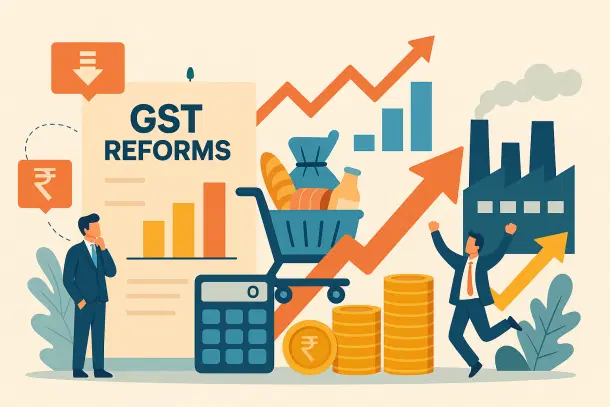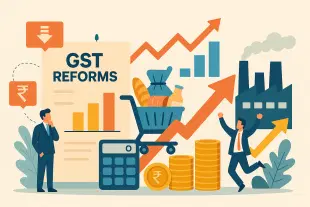Economy
Here Are The Key Takeaways From SBI Research Report On GST 2.0
Swarajya Staff
Aug 23, 2025, 01:02 PM | Updated 01:03 PM IST
Save & read from anywhere!
Bookmark stories for easy access on any device or the Swarajya app.


A new research report from the State Bank of India (SBI) has suggested that the proposed GST 2.0 reforms could stimulate consumption, ease inflationary pressures, and even generate additional revenue for the government, despite an initial loss of tax collections.
The report comes ahead of the GST Council’s September meeting, which will be responsible for the eventual rationalisation of the GST slabs.
Here are seven key takeaways from the report:
1. Revenue Loss Will Be Manageable
Currently, the GST operates with four tax slabs–5 per cent, 12, 18, and 28.
The report estimates that the 12 and 28 per cent slabs would be removed and only the 5 per cent and 18 per cent tax slabs would remain. Additionally, a new slab of 40 per cent for sin goods would be introduced.
From this, the report presents two scenarios, based on probable classification of goods under the 5 and 18 per cent slabs (and the sin goods under 40 per cent).
The study estimates that rationalisation of GST rates could cause an average revenue shortfall of around Rs 85,000 crore (Rs 1.1 lakh crore in Scenario 1, and Rs 60,000 crore in Scenario 2).
2. Higher Consumption To Offset Losses
The report projects that the additional purchasing power unleashed by lower effective GST rates could add Rs 5.5 lakh crore to consumption.
Of this, nearly Rs 52,000 crore may directly return to the exchequer through GST collections.
3. Effective GST Rate To Fall Further
The weighted average GST rate, which was 14.4 per cent when the system was rolled out in 2017 and 11.6 per cent by 2019, is projected to fall further to 9.5 per cent under GST 2.0.
While this represents a decline in effective tax incidence, the bank sees it as a reform that would benefit both consumers and businesses by boosting demand.
4. Rationalisation Will Help Contain Inflation
SBI estimates that the reform could reduce consumer price index (CPI) inflation by 20–25 basis points, with food and textiles alone contributing 10–15 bps of that decline.
5. Minimal Fiscal Deficit Impact
Despite the initial shortfall, SBI believes the fiscal deficit impact will be contained to just 5–10 basis points. This is partly because the GST Compensation Fund is expected to show a surplus of about Rs 45,000 crore by March 2026, which could be deployed to offset revenue pressures.
6. Strong Economic Multiplier Effect
Using a tax multiplier of 2.33, SBI argues that GST rationalisation alone could boost consumption demand by Rs 1.98 lakh crore. Combined with recent cuts in personal income tax, the total additional consumption stimulus could be as high as Rs 5.3 lakh crore, or 1.6 per cent of GDP.
7. No Trade-Off Between Reforms And Growth
The report rejects the notion of a zero-sum trade-off between government revenue and consumption. It argues “GST 2.0 could unleash a consumption boost and hence higher tax revenue, lower inflation and higher growth”.
Also Read: Massive Indirect Tax Reforms On Cards As GST Council Set To Meet On 3-4 September





